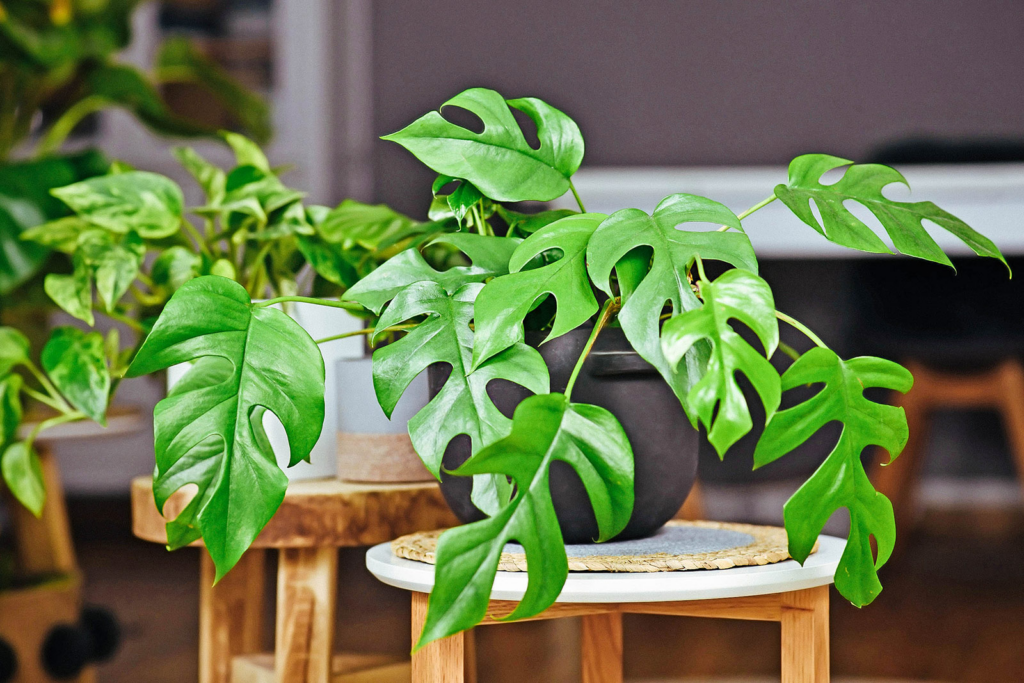How to Grow and Care for Rhaphidophora Decursiva (2024)
Rhaphidophora Decursiva is also known as the Decursiva plant that is native to Southeast Asia. This plant produces green satin leaves that tend to fenestrate in its Juvenile phase. Hey folks! I am Anna Scott, a Gardener with 15 years of gardening experience, now I am here to help other gardeners.
This plant produces fenestrated leaves and is also known as dragon tail plant. It is a popular houseplant that is a close relative of the “mini monstera” (Rhaphidophora tetrasperma). It is because of the growing habit of the plant that produces dark glossy leaves in the plant. When the plant becomes mature, its fenestrated leaves appear. They begin to look like palm leaves.
So, what else do you need? I am here with the proper guide to understand how to grow and care for Rhaphidophora Decursiva in your home garden. Stay connected with this guide till the end for its proper understanding.
| Scientific Name | Rhaphidophora decursiva |
| Common Name | Decursiva plant, Dragon’s Tail, Monstera decursiva |
| Light | Bright filtered light to partial Shade |
| Watering | 1-2 times in a week |
| Temperature | 60 to 80°F or (15.6 to 26.7°C) |
| Hardiness Zone | USDA hardiness zones 10 to 12 |
| Humidity | More than 60% |
| Soil Type | Rich, well-draining |
| Soil pH | Slightly acidic (5.6 to 6.5 pH) |
| Fertilizing | A balanced feed once a month in spring and summer |
| Repotting | Every 1 or 2 years |
| Pruning | Beginning of the growing season |
| Propagation | Stem cuttings, Air layering |
| Toxicity | Toxic to humans and pets |
| Mature Size | 5-8 meters as a houseplant |
| Bloom Time | Late spring, early summer |
What is Rhaphidophora decursiva?
Rhaphidophora Decursiva is a climbing species that is every gardener’s adorable choice to add to their collection. This plant is famous for its lush foliage. This evergreen plant produces dark-colored oval-shaped leaves. It is native to China and is found in various locations like Cambodia, Vietnam, Laos, and the Philippines.

During the juvenile phase, this plant will be fenestrated and after maturity, this plant will develop pinnate leaves and become more shiny. This plant has the air-cleaning ability despite its looks. Grow this variety as this ornamental variety will cherish your area with its amazing appearance.
How to Grow and Care for Rhaphidophora Decursiva?
Rhaphidophora Decursiva is one of the fast-growing plants that grow best if it receives ideal conditions. So, follow the below tips to know how to grow and care for Rhaphidophora Decursiva in your garden area. They are as follows:
Sunlight
- This plant likes to grow in the dappled sunlight as it belongs to its native area where it receives sunlight from the canopy.
- When it is grown inside the house, then the plant will like to receive bright indirect sunlight for its growth.
- Do not let the plant receive bright sunlight for long as it will hurt the plant’s growth. Low-light sunlight should also be avoided.
- Make use of grow lights if there is a lack of sunlight to prevent brown leaf tips in the plant.
Soil
- Rhaphidophora Decursiva will grow in a well-drained soil mix that is light and nutrient-rich.
- Make the soil mix by mixing equal parts of perlite, and orchid bark in the potting mix, it will make a great mixture for the plant.
- These components will help in increasing the aeration in the soil and prevent compact soil in the plant by retaining the excess moisture.

Water
- What about the watering routine of the Rhaphidophora Decursiva? It needs water when the top inches of the soil becomes fully dry.
- The general rule of thumb for this plant is the soak and dry method which means the water should be given after checking the soil’s moisture.
- Insert the finger inside the soil about 1-2 inches deep and if it feels dry, then only water the plant.
- During fall and winter, do not water the plant as the plant is in its dormant period at that time or you can reduce the watering frequency.
- Keep watering the plant in the summer until the water flows out from the drainage holes.
Note: Avoid overwatering in the plant to prevent fungal infections like root rot in the plant.
Temperature and Humidity
- The ideal temperature range for this plant lies between 65 to 80 degrees Fahrenheit (18 to 26 degrees Celsius).
- Being a tropical plant, it is not a cold, hardy plant, making it a great plant to grow indoors.
- Its USDA hardiness growing zones are 9 – 11. It can tolerate average humidity for its growth.
- If the humidity is low, then raise the humidity by installing a humidifier near the plants or keep the plants in the bathroom or kitchen area.
Fertilizer
- Fertilizers help in growing plants at a faster pace. It is not too demanding when it comes to the fertilizer needs of this plant.
- Rhaphidophora Decursiva needs regular fertilization, especially in the spring and summertime.
- Make use of balanced liquid fertilizers for the plant one time in a month after you water the plant.

Potting and Repotting
- Being a fast-growing plant, it needs repotting within a few years of growing the plant.
- This plant can easily become root-bound, as it has a deep root system. This plant needs repotting after every one year.
- It also depends on the environmental factors received by the plant, so if the plant grows slowly, then it has to be repotted after every two years.
- Make use of fresh soil mix for the plant at the time of repotting. Gently, take out the plant and remove the excess soil from it.
- Choose a container that is 1-2 inches bigger than the current pot in diameter.
Pruning
- Pruning is needed by the Rhaphidophora Decursiva to maintain its healthy shape and size.
- Prune the foliage when it becomes dull because of various spoiled stems and foliage.
- It will help in preventing the infection in the plan. Make use of sharp and sterilized scissors for timing the plant.
- Also, do not prune more than 1/3rd of its foliage. Trim off all the dead and diseased leaves from the plant.
- It will stimulate the plant’s growth at its best. The plant will be looking more healthy and fuller than before.
Note: Prune the plant in the early springtime to see the best results.
Propagation
- First, make use of clean and sharp sterilized scissors to take the stem cuttings from the parent plant.
- Then, cut stem cuttings from the plant that should contain 2 to 3 nodes in every cutting.
- Remove the leaves from the base of the nodes and the remaining leaves in the cuttings.
- Then, put the cuttings in the container filled with water at the bottom and keep the leaves above the water.
- Place your cuttings at a location where they can receive plenty of bright, indirect sunlight.
- Water the plants once a week so that they grow well. After 15 to 20 days, tiny roots will come from the nodes.
- Then when it becomes 1 inch long, you can move it in the soil by making use of a well-drained potting mix for your plant.
- By planting the cutting in the soil, water the plant till the excess water flows out from the drainage holes.
- Last but not least, place the plant in bright indirect sunlight so that it grows well.
Pro tip: You can resume watering after 10 to 15 days to keep the plant healthy.

Common Problems with Rhaphidophora Decursiva
Rhaphidophora Decursiva will face various problems if the plant does not receive proper care. It leads to various pests, diseases, and other problems, as explained below. These problems can cause severe damage if they are not treated on time. So, look after those common problems with the Rhaphidophora Decursiva to prevent them. They are as follows:
Yellow leaves
- Yellow leaves appear in the plant because of an excess supply of water to the plants.
- Check the moisture of the soil before watering the plant. Insert the finger about 1-2 inches deep, and if the soil is dry, then only water the plant.
Variegation Loss
- If the plant does not receive plenty of sunlight for its growth, then it leads to a loss of variegation in the plant.
- So, it is suggested to change the plant location so that it can receive a good amount of bright indirect sunlight.
Legginess
- Legginess is one of the common problems of various plants. It means that the plant has no leaves but only long vines.
- The best thing to do to prevent these issues is to prune the plant on time. Remove the leggy growth from the plant.

Pests
- Various pests come to a plant to spoil its growth by sucking its fluid to satisfy its hunger.
- Some pests like mealybugs, aphids, and thrips will weaken the plant’s growth and it will die with time.
- So, make use of any horticultural oil such as neem oil on the plant to treat these issues.
Diseases
- Last but not least, a few diseases like fungal or bacterial infections affect the plant’s growth.
- It happens due to the root rot (Caused by overwatering). Treat the plant by feeding it with the right amount of water.
Summing up the context
In this guide, you come to know that Rhaphidophora Decursiva is a climbing species that is every gardener’s adorable choice to add to their collection. This plant is famous for its lush foliage. This plant produces fenestrated leaves and is also known as dragon tail plant. It is a popular houseplant that is a close relative of the “mini monstera” (Rhaphidophora tetrasperma). It is because of the growing habit of the plant that produces dark glossy leaves in the plant.
When the plant becomes mature, its fenestrated leaves appear. They begin to look like palm leaves. This evergreen plant produces dark-colored oval-shaped leaves. It is native to China and is found in various locations like Cambodia, Vietnam, Laos, and the Philippines. I hope you are clear with the guide. Read the whole guide properly for its good understanding. I will come back with another informative guide soon.
Thanks for reading! Happy Gardening!
FAQs
Is Rhaphidophora decursiva fast-growing?
Yes, Rhaphidophora decursiva is one of the fast-growing varieties.
How fast does Rhaphidophora grow?
This plant grows quickly in your home garden. If the plant receives the right caring conditions, then it will grow about 1-2 feet long every year.


